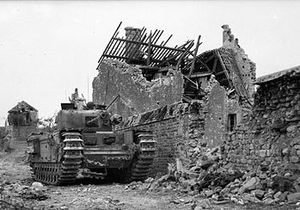.gif)
6th Guards Tank Brigade (United Kingdom)
Encyclopedia
The 6th Guards Tank Brigade was formed in 1941 as the 6th Guards Armoured Brigade when Great Britain was under the threat of invasion and more armoured formations were required, permission was granted from King George VI and the Colonels of the Regiments involved and over the summer of 1941, the Infantry of the Guards
converted into an armoured formation and so the Guards Armoured Division was formed which contained the 5th Guards Armoured Brigade
and the 6th Guards Armoured Brigade.
In 1942 all British armoured divisions were reorganised to have one armoured brigade and one motor brigade. The 6th Guards Armoured became an independent tank brigade being renamed as the 6th Guards Tank Brigade.
The brigade now equipped with the Churchill tank
, served in the North West Europe Campaign
landing in Normandy
on 20 July 1944.
They went onto take part in Operation Bluecoat
, Operation Veritable
finally ending the war at Lübeck
on the Baltic Sea
where they captured a U-boat
.

Brigade of Guards
The Brigade of Guards is a historical elite unit of the British Army, which has existed sporadically since the 17th century....
converted into an armoured formation and so the Guards Armoured Division was formed which contained the 5th Guards Armoured Brigade
5th Guards Armoured Brigade
The 5th Guards Armoured Brigade was a Second World War British Army formation, a component unit of the Guards Armoured Division.- History :This brigade was converted from the 20th Infantry Brigade on 15 September 1941. It was stationed in the United Kingdom until 30 June 1944 when it arrived in...
and the 6th Guards Armoured Brigade.
In 1942 all British armoured divisions were reorganised to have one armoured brigade and one motor brigade. The 6th Guards Armoured became an independent tank brigade being renamed as the 6th Guards Tank Brigade.
The brigade now equipped with the Churchill tank
Churchill tank
The Tank, Infantry, Mk IV was a heavy British infantry tank used in the Second World War, best known for its heavy armour, large longitudinal chassis with all-around tracks with multiple bogies, and its use as the basis of many specialist vehicles. It was one of the heaviest Allied tanks of the war...
, served in the North West Europe Campaign
North West Europe Campaign
The North West Europe Campaign was the name given by the British and Commonwealth armed forces to the two land campaigns they fought on the Western Front during World War II....
landing in Normandy
Normandy
Normandy is a geographical region corresponding to the former Duchy of Normandy. It is in France.The continental territory covers 30,627 km² and forms the preponderant part of Normandy and roughly 5% of the territory of France. It is divided for administrative purposes into two régions:...
on 20 July 1944.
They went onto take part in Operation Bluecoat
Operation Bluecoat
Operation Bluecoat was an attack by the British Second Army at the Battle of Normandy during the Second World War, from 30 July – 7 August 1944. The geographical objectives of the attack were to secure the key road junction of Vire and the high ground of Mont Pinçon...
, Operation Veritable
Operation Veritable
Operation Veritable was a Second World War pincer movement conducted by Field Marshal Bernard Montgomery's 21st Army Group to clear and occupy the land between the Rhine and Maas rivers. It took place between 8 February and 11 March 1945. It was a part of General Dwight Eisenhower's "broad front"...
finally ending the war at Lübeck
Lübeck
The Hanseatic City of Lübeck is the second-largest city in Schleswig-Holstein, in northern Germany, and one of the major ports of Germany. It was for several centuries the "capital" of the Hanseatic League and, because of its Brick Gothic architectural heritage, is listed by UNESCO as a World...
on the Baltic Sea
Baltic Sea
The Baltic Sea is a brackish mediterranean sea located in Northern Europe, from 53°N to 66°N latitude and from 20°E to 26°E longitude. It is bounded by the Scandinavian Peninsula, the mainland of Europe, and the Danish islands. It drains into the Kattegat by way of the Øresund, the Great Belt and...
where they captured a U-boat
U-boat
U-boat is the anglicized version of the German word U-Boot , itself an abbreviation of Unterseeboot , and refers to military submarines operated by Germany, particularly in World War I and World War II...
.

Commanders
- 15 January 1943 – 3 August 1944 Brigadier GL VerneyGerald Lloyd-VerneyMajor-General Gerald Lloyd-Verney DSO & Bar MVO was a British Army officer who commanded 7th Armoured Division during World War II. He changed his name by Deed poll from Gerald Lloyd Verney to Gerald Lloyd-Verney in 1941....
- 3 August 1944 – 16 August 1944 Brigadier Sir Walter Bartellot, Bt
- 18 August 1944 – 2 February 1945 Brigadier WDC Greenacre
Formation
- 4th Motor Battalion Coldstream GuardsColdstream GuardsHer Majesty's Coldstream Regiment of Foot Guards, also known officially as the Coldstream Guards , is a regiment of the British Army, part of the Guards Division or Household Division....
- 4th Armoured Battalion Grenadier GuardsGrenadier GuardsThe Grenadier Guards is an infantry regiment of the British Army. It is the most senior regiment of the Guards Division and, as such, is the most senior regiment of infantry. It is not, however, the most senior regiment of the Army, this position being attributed to the Life Guards...
- 3rd Armoured Battalion Scots GuardsScots GuardsThe Scots Guards is a regiment of the Guards Division of the British Army, whose origins lie in the personal bodyguard of King Charles I of England and Scotland...
- 2nd Armoured Battalion Welsh GuardsWelsh GuardsThe Welsh Guards is an infantry regiment of the British Army, part of the Guards Division.-Creation :The Welsh Guards came into existence on 26 February 1915 by Royal Warrant of His Majesty King George V in order to include Wales in the national component to the Foot Guards, "..though the order...

